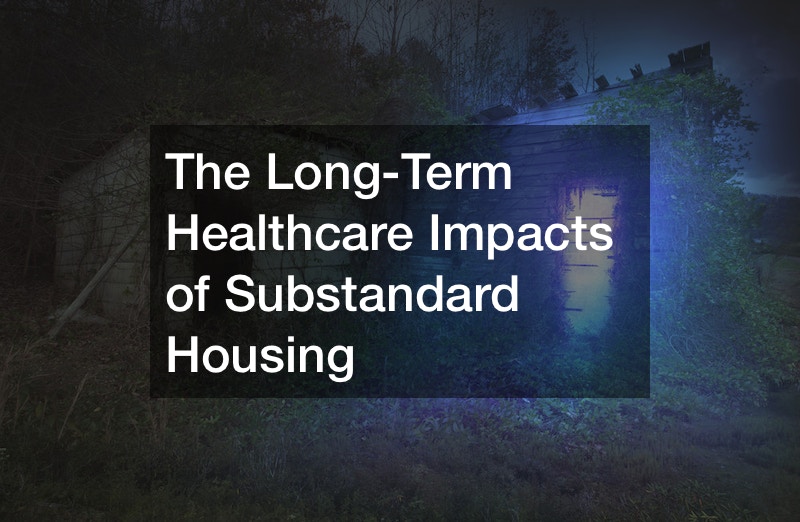
Living in substandard housing can have a significant impact on one’s health. Poorly maintained homes can harbor mold, lead, and other environmental hazards that can cause or contribute to various health problems. For example, children exposed to lead paint risk developing learning disabilities and behavior problems. Adults who live in homes with mold or poor indoor air quality may suffer from respiratory problems, headaches, and fatigue.
In the long term, the health effects of substandard housing can be even more serious. Below are the long-term healthcare impacts that have been linked to living in substandard housing.
Increased Risk of Chronic Diseases
People who live in substandard housing are more likely to develop chronic diseases such as heart disease, diabetes, and asthma. Chronic diseases are linked to a variety of factors, including genetics, lifestyle, and environment. Poor housing conditions can play a role in developing chronic diseases by increasing exposure to environmental hazards, such as lead and mold. Sadly, little can be done to reverse the damage once it’s completed. That’s why it’s essential to address substandard housing before it leads to serious health problems.
In addition, people who live in substandard housing often don’t have access to the resources they need to manage their chronic diseases. For example, they may not have the money to pay for medications or the transportation to get to doctor’s appointments. This can lead to a decline in their health and an increased risk of complications from their chronic diseases. Therefore, it’s best to try and find housing that meets your needs before you develop a chronic disease. If you are concerned about a particular neighborhood or building, you can always contact the local health department to see if there have been any complaints about the conditions. There are also tests, such as radon gas testing, that can be done to ensure the safety of your home.

Mental Health Problems
Living in substandard housing can also lead to mental health problems, such as anxiety and depression. This is often the result of the stress that comes with living in poor conditions. For example, if you’re constantly worrying about your home being flooded or infested with pests, it can take a toll on your mental health. In addition, the financial burden of living in substandard housing can also contribute to mental health problems. If you’re struggling to pay the rent or keep up with repairs, it can cause a lot of stress and anxiety.
If you’re struggling with your mental health, it’s important to seek help from a professional. Many resources are available to help you cope with the stress of living in substandard housing. In addition, there are programs available that can help you find safe and affordable housing. If you’re not sure where to start, you can always contact your local social services agency for more information.
Increased Risk of Injury
Another long-term healthcare impact of substandard housing is an increased risk of injury. This is often the result of poor maintenance and safety hazards. For example, if there are loose stairs or electrical wiring, it can increase the risk of falls and electric shocks. In addition, homes that are infested with pests may also pose a danger to your health. Pests can bite or scratch you, and some, like rats, can spread diseases. If you’re living in substandard housing, it’s important to be aware of the safety hazards and take steps to protect yourself.
Suppose you have any concerns about the safety of your home. In that case, you should contact the local building inspector and try to update your home or living area as much as possible with professional contractors. For instance, roofing contractors can provide professional roofing service to ensure your home is up to code and has no structural issues.

Increased Risk of Infection
Another concern associated with substandard housing is an increased risk of infection. Infections are often the result of exposure to environmental hazards or living in tight quarters. In addition, homes infested with rodents and other small animals may also be more likely to harbor bacteria and viruses. If you’re living in substandard housing, you might be in close contact with other tenants or animals that carry diseases. It’s essential to practice good hygiene and try to avoid contact with sick people or animals to reduce your risk of infection.
If you’re worried about the cleanliness of your home, you can seek the help of a residential cleaning service that can clean and disinfect your home. In addition, you should seek medical care if you believe you are suffering from an infection. In close-knit quarters, some of the most common infections include the flu, the common cold, and gastroenteritis. Other serious infections include MRSA, which is a type of staph infection that is resistant to antibiotics. If you’re suffering from a fever, chills, or body aches, or the long-term healthcare impacts of living in poor housing, it’s important to seek medical attention as soon as possible.
Increased Risk of Dehydration
One of the most serious of the long-term healthcare impacts of substandard housing is an increased risk of dehydration. Dehydration is more common in the summer, and occurs when living in a hot climate and not having access to clean water. If you’re living in an area with a lot of dust and dirt, it can also contribute to dehydration. In addition, homes that are not up-to-date with their air conditioning system might put you at a higher risk for dehydration. If you’re living in substandard housing, it’s important to drink plenty of fluids and stay away from the heat as much as possible.
If you’re concerned about the long-term healthcare impacts of dehydration, it’s important to seek medical attention as soon as possible. Dehydration can lead to serious health complications, such as heat stroke, kidney failure, and even death. In addition, it’s important to stay hydrated by drinking plenty of fluids, such as water and juice. You should also avoid alcoholic beverages, as they can actually contribute to dehydration. Call an HVAC company for heating and air conditioning maintenance, and make sure your home is up-to-date with the latest air conditioning system.

Increased Risk of Water Contamination Diseases
Contaminated water is another serious concern associated with substandard housing. If you’re living in an area with contaminated water, you’re at a higher risk for developing waterborne diseases. These diseases can be very serious, and include cholera, dysentery, and typhoid fever. In addition, contaminated water can also lead to the spread of other diseases, such as hepatitis A. It’s important to practice to call a drain cleaning service to ensure that the water in your home is clean and safe to drink.
Sadly, the long-term healthcare impacts of water contamination are extremely serious and fatal. Waterborne diseases can lead to serious health complications, such as organ failure, and even death. In addition, if you have any open wounds, it’s important to keep them clean and covered and not use contaminated water to treat them. Some signs of waterborne diseases include vomiting, diarrhea, and fever. Any of these symptoms warrant a trip to the hospital. Additionally, if you notice your water looks or smells strange, you should contact the local water company and have it tested.
Increased Risk of Pest Infestations
Pest infestations are another major concern associated with substandard housing. If you’re living in an area with a lot of pests, you’re at a higher risk for developing pest-borne diseases. These diseases can be very serious and even fatal. Some of the most common pest-borne diseases include the bubonic plague, Lyme disease, and West Nile virus. In addition, pests can also spread other diseases, such as salmonella and E. coli. If you’re living in substandard housing, it’s important to call an exterminator or alert your landlord as soon as possible.
The long-term healthcare impacts of pest infestations are extremely serious and can be spread by even the smallest of creatures. From ticks to cockroaches and rodents, pests of all sizes can have negative impacts on your health. Prevent pests from coming into your home by sealing cracks and crevices, and keep food stored in airtight containers. If you do have a pest infestation, it’s important to call a professional exterminator as soon as possible. Additionally, if you’re bitten or stung by a pest, it’s important to visit your doctor or a hospital as soon as possible. A medical doctor can determine if the bite or sting is harmful and prescribe the appropriate treatment.

Increased Risk of Mold and Mildew-Related Problems
Mold and mildew are another major concerns associated with substandard housing. If you’re living in an area with a lot of mold or mildew, you have a higher risk of developing respiratory problems. These respiratory problems can make it difficult to breathe and lead to long-lasting issues, including asthma and bronchitis. In addition, mold and mildew can also cause skin irritation and allergic reactions. If you’re living in substandard housing, it’s important to call a mold remediation company or water damage restorations as soon as possible.
The long-term healthcare impacts of mold and mildew are extremely serious and can have lasting effects on your health. Mold and mildew can cause serious respiratory problems, cause skin irritation, trigger allergies that could lead to anaphylactic shock, and even cause cancer. Whether you need mildew removal or mold remediation, it’s important to call a professional as soon as possible. Additionally, if you’re experiencing any health problems that you think could be related to mold or mildew, it’s important to seek medical attention as soon as possible.
Increased Risk of Lung Cancer
Did you know that particles from fireplaces have been linked to lung cancer, according to the EPA? Sadly, many substandard homes don’t have access to clean-burning fireplaces, which can put the residents at an increased risk for developing lung cancer. Additionally, poor ventilation in substandard homes can lead to the buildup of harmful toxins and chemicals, which can also increase the risk of lung cancer. If you’re living in substandard housing, it’s important to install a carbon monoxide detector and make sure the home is well-ventilated.
A properly ventilated home or rental can help reduce the risk of lung cancer. If you have a fireplace, it’s important to make sure it’s clean-burning and that the chimney is free of debris. Additionally, it’s important to install a carbon monoxide detector in the home and to keep the detector up-to-date. If you think you may have been exposed to harmful toxins or chemicals, call your doctor right away for advice.
Increased Risk of Lead Poisoning
One of the most serious health concerns associated with substandard housing is the risk of lead poisoning. If you’re living in an older home, there’s a good chance the paint contains lead. When the paint begins to chip and the dust is inhaled, it can lead to lead poisoning. Lead poisoning can cause serious health problems, including brain damage, anemia, kidney disease, and even death. If you’re living in substandard housing, it’s important to have the home tested for lead and to call a professional lead removal company if the test comes back positive. Don’t put your health at risk, and instead, call a professional lead removal company if you think there’s lead in your home.
There are a number of health concerns associated with substandard housing. These health concerns include the increased risk of mold and mildew-related problems, the increased risk of lung cancer, the increased risk of lead poisoning, and the increased risk of pests and diseases among others. If you’re living in substandard housing, it’s important to take steps to protect your health.


